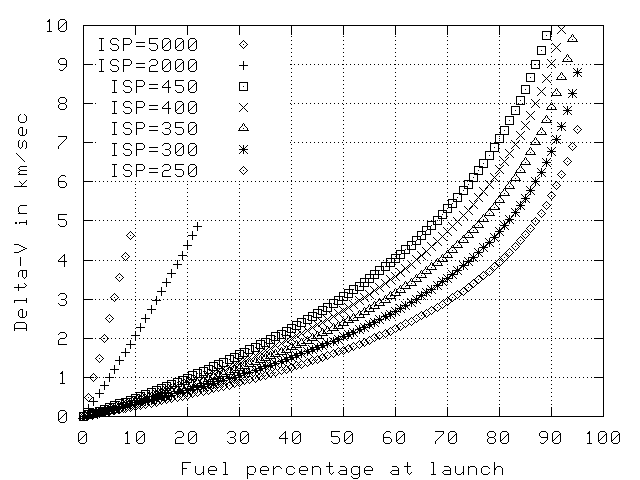
A formula called the rocket equation calculates how fast a single stage rocket can go. The critical term in the formula is the isp, which is a measure of how powerful the rocket fuel is per pound, and the percentage of the takeoff weight that is fuel. The formula for change in velocity is: DeltaV = isp * g * ln(Mo/Mf) . Mo is mass at liftoff and Mf is mass after burn (the final mass). The ratio Mo/Mf is called the mass ratio. This is the lift off mass divided by the final mass. The term 'g' is the acceleration of gravity. So the DeltaV scales linearly with the isp and with the natural log of the mass ratio. The inverse of the mass ratio is the fuel fraction, which seems easier to think about. We plot the DeltaV as a function of fuel fraction for several different isp values in the following graph.
An X-prize vehicle with an ISP of 250 needs to have about 45% fuel percentage. This is not that far from the SSTT 75% fuel percentage. If you removed wings, landing gear, and presurization from an X-prize class vehicle you might get to 0.75 fuel.
For comparison a SSTO vehicle needs to be about 0.96 fuel. It should be possible to evolve one of the X-prize vehicles into something like the SSTT rocket that SpaceTether's proposal requires. If so, the development costs might not be very high.
http://www.shuttlepresskit.com/expedition1/03-soyuz_launch.htm
The materials for composite tanks have improved. It is now possible to make pressure tanks for rockets out of composites. Two examples are the tanks for the Space Ship One at Scaled Composites and the Scorpius tanks at Microcosm Inc..
There are engines that are cooled by internal ablation which are lighter than a regeneratively cooled engine. But these engines are for a single use. It may be possible to design one that can be refurbished.
Regenerative cooled engines have proven that they can be reused many times, so they are the established technology for reusable rockets.
| Rocket | Stage | Fuel Type | Fuel Kg | Dry Kg | Dry/Fuel |
|---|---|---|---|---|---|
| Delta-IV | 1 | LOX/LH2 | 200,000 | 18,030 | 9.02% |
| Delta-IV | 2 - 4mf | LOX/LH2 | 20,412 | 2,718 | 13.32% |
| Titan-IVB | 1 | N2O4/Aerozine | 155,000 | 8,000 | 5.16% |
| Titan-IVB | 2 | N2O4/Aerozine | 35,000 | 4,500 | 12.86% |
| Titan-IVB | Centaur | LOX/LH2 | 20,950 | 2,930 | 13.99% |
| Ariane 5 | 1 | LOX/LH2 | 155,000 | 15,000 | 9.68% |
| Ariane 5 | 2 | N2O4/MMH | 9,700 | 1,200 | 12.37% |
| Zenit 2 | 1 | LOX/RP | 320,907 | 32,893 | 10.25% |
| Zenit 2 | 2 | LOX/RP | 80,900 | 9,600 | 11.87% |
| Zenit 2 | 3 | LOX/Syn-Thin | 14,650 | 2,550 | 17.41% |
| Long March 3 | 1 | N2O4/UDMH | 144,000 | 7,000 | 4.86% |
| Long March 3 | 2 | N2O4/UDMH | 35,000 | 4,000 | 11.43% |
| Long March 3 | 3 | LOX/LH2 | 8,500 | 2,000 | 23.53% |
| Soyuz | strap-on | LOX/RP | 39,200 | 3,550 | 9.06% |
| Soyuz | 1/core | LOX/RP | 94,500 | 6,500 | 6.88% |
| Soyuz | 2 | LOX/RP | 23,000 | 2,400 | 10.43% |
| Soyuz | 3 | LOX/RP | 3,450 | 1,050 | 30.43% |
| Rocket | GLOW | Dry Mass | Dry Mass Fraction |
Click for SpaceTethers.com
Copyright (c) 2002, 2003 by Vincent Cate. All rights reserved.